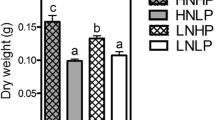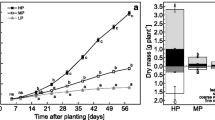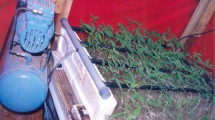Summary
In Hordeum vulgare, phosphorus retranslocation was studied after it had been supplied to the roots for three days (experiment 1), and after foliar application (experiments 3–8). Phosphorus uptake by leaves of different ages was also measured 16 and 60 minutes after 32P addition to the medium (experiment 2).
In experiment 1, treatments at 0.6 and 31 p.p.m. of phosphorus were applied when the first leaf had completed its rapid growth. The plants were then grown for three days in media labelled with 32P, and for a subsequent 10 days in non-labelled solutions. Retranslocation was measured by changes in total phosphorus and in 32P.
Both root feeding, and foliar application of 32P, demonstrated three phases during leaf development: import (recently initiated leaf), export (mature leaf) and an intermediate phase with both export and import (leaf half developed).
There was large transport of foliar applied 32P, from mature leaves to roots, and some of this 32P was re-exported to the shoots, including the mature leaves. Root feeding of 32P over short periods strongly suggested that phosphorus uptake by the shoots occurred via the xylem, even at low phosphorus.
In experiment 1, there were distinct treatment differences in relative growth rates, growth of young organs and roots, and in phosphorus concentrations of all but the very young leaves. Mature leaves showed a large net phosphorus export at low phosphorus, but a large net import at high phosphorus. This was not due to treatment differences in export, because total export from the mature leaves was even somewhat smaller at low than at high phosphorus. The treatment differences, with net export at low but net import at high phosphorus, were thus due to the higher import in the mature leaves at high phosphorus. Total export remained at a high level throughout the experiment at high phosphorus, while it declined with time at low phosphorus.
For phosphorus absorbed during early growth, both the export from the mature leaves, and the intake by the developing leaves, was independent of phosphorus treatment; i.e. for each individual organ the quantities of phosphorus involved were the same in the two phosphorus treatments. Thus, the higher phosphorus contents of developing organs at high phosphorus were obtained from phosphorus supplied to the roots during later growth, and not from phosphorus supplied during early growth of the whole plant.
The data are consistent with the notion that phosphorus export is controlled in the source. It is suggested that at high phosphorus this control is due to a saturation of the sites transporting phosphorus into the phloem. At low phosphorus, on the other hand, release from individual leaf cells might have been the dominating factor.
Similar content being viewed by others
References
Arnon, D. I., and D. R. Hoagland: Crop production in artificial culture solutions and in soils with special reference to factors influencing yields and absorption of inorganic nutrients. Soil Sci. 50, 463–484 (1940).
Biddulph, O.: Diurnal migration of injected radiophosphorus from bean leaves. Amer. J. Bot. 28, 348–352 (1941).
—: Translocation of inorganic solutes. In: Plant physiology, vol. 2 Plants in relation to water and solutes, (ed. F. C. Steward), chap. 6, p. 553–603. New York: Academic Press Inc. 1959.
—, and Jane Markle: Translocation of radio-phosphorus in the phloem of the cotton plant. Amer. J. Bot. 31, 65–70 (1944).
Bollard, E. G.: Transport in the xylem. Ann. Rev. Plant Physiol. 11, 141–166 (1960).
Briggs, G. E., A. B. Hope, and R. N. Robertson: Electrolytes and plant cells. Oxford: Blackwell 1961.
Greenway, H., A. Gunn, M. G. Pitman, and D. A. Thomas: Plant response to saline substrates. VI. Chloride, sodium, and potassium uptake and distribution within the plant during ontogenesis of Hordeum vulgare. Aust. J. biol. Sci. 18, 525–540 (1965).
—, and M. G. Pitman: Potassium retranclocation in seedlings of Hordeum vulgare. Aust. J. biol. Sci. 18, 135–147 (1965).
Gregory, F. G.: Mineral nutrition of plants. Ann. Rev. Biochem. 4, 557–578 (1937).
—: The control of growth and reproduction by external factors. Rep. 13th Int. Hort. Congr., 1952, 1, 96–105 (1953).
Hoad, G. V., and A. J. Peel: Studies on the movement of solutes between the sieve tubes and surrounding tissues in willow. I. Interference between solutes and rate of translocation measurements. J. exp. Bot. 16, 433–451 (1965).
Jeschke, W. D., and W. Simonis: On the uptake of phosphate and sulphate ions by Elodea densa, as influenced by light, temperature, and external concentrations. Planta (Berl.) 67, 6–32 (1965).
Jones, H., R. V. Martin, and H. K. Porter: Translocation of 14Carbon in tobacco following assimilation of 14Carbon dioxide by a single leaf. Ann. Bot. 23, 493–508 (1959).
Koontz, H., and O. Biddulph: Factors affecting absorption and translocation of foliar aplied phosphorus. Plant Physiol. 32, 463–470 (1957).
Mason, T. G., and E. G. Maskell: Further studies on transport in the cotton plant. I. Preliminary observations on the transport of phosphorus, potassium, and calcium. Ann. Bot. 45, 125–173 (1931).
Moorby, J.: The foliar uptake and translocation of caesium. J. exp. Bot. 15, 457–469 (1064).
Shiroya, M., G. R. Lister C. D. Nelson, and G. Krotkov: Translocation of C14 in tobacco at different stages of development following assimilation of C14O2 by a single leaf. Canad. J. Bot. 39, 855–864 (1961).
Smith, R. C., and E. Epstein: Ion absorption by shoot tissue: technique and first findings with excised leaf tissue of corn. Plant Physiol. 39, 338–341 (1964).
Stout, P. R., and D. R. Hoagland: Upward and lateral movement of salt in certain plants as indicated by radioactive isotopes of potassium, sodium, and phosphorus absorbed by roots. Amer. J. Bot. 26, 320–324 (1939).
Swanson, C. A., and J. B. Whitney: Studies on the translocation of foliar-applied P32 and other radioisotopes in bean plants. Amer. J. Bot. 40, 816–823 (1953).
Thrower, Stella L.: Translocation of labelled assimilates in the soybean. II. The pattern of translocation in intact and defoliated plants. Aust. J. biol. Sci. 15, 629–649 (1962).
Trip, P., C. D. Nelson, and G. Krotkov: Selective and preferential translocation of C14 labeled sugars in white ash and liae. Plant Physiol. 40, 740–747 (1965).
Wardlaw, I. F.: The velocity and pattern of assimilate translocation in wheat plants during grain development. Aust. J. biol. Sci. 18, 269–281 (1965).
Watson, Ruth, and A. H. K. Petrie: Physiological ontogeny in the tobacco plant 4. The drift in nitrogen content of the parts in relation to phosphorus supply and topping, with an analysis of the determination of ontogenetic changes. Aust. J. exp. Biol. med. Sci. 18, 313–340 (1940).
Williams, R. F.: Physiological ontogeny in plants and its relation to nutrition 2. The effect of phosphorus supply on the growth of the plant, and its parts. Aust. J. exp. Biol. med. Sci. 14, 165–185 (1936).
—: The effects of phosphorus supply on the rates of intake of phosphorus and nitrogen and upon certain aspects of phosphorus metabolism in gramineous plants. Aust. J. Sci. Res. B 1, 333–361 (1948).
—: Redistribution of mineral elements during development. Ann. Rev. Plant Physiol. 6, 25–42 (1956).
Zimmermann, M. H.: Transport in the phloem., Ann. Rev. Plant. Physiol. 11, 167–190 (1960).
Author information
Authors and Affiliations
Rights and permissions
About this article
Cite this article
Greenway, H., Gunn, A. Phosphorus retranslocation in Hordeum vulgare during early tillering. Planta 71, 43–67 (1966). https://doi.org/10.1007/BF00384642
Received:
Issue Date:
DOI: https://doi.org/10.1007/BF00384642




